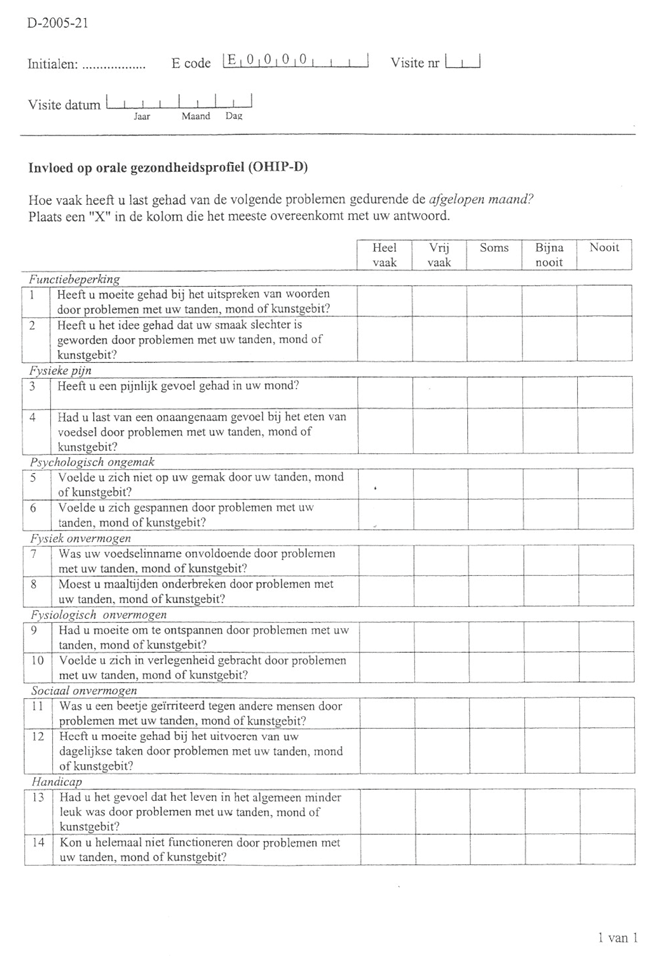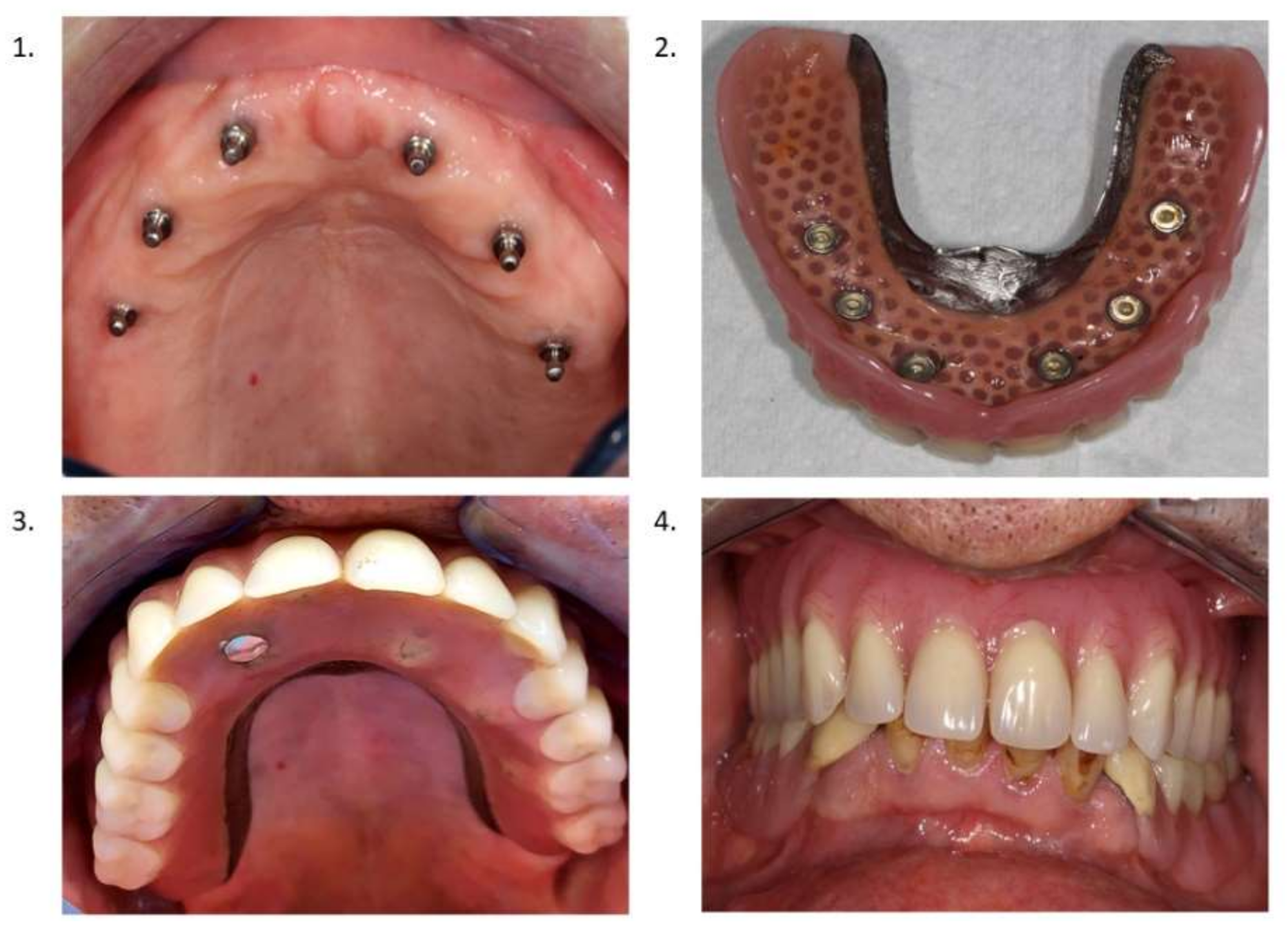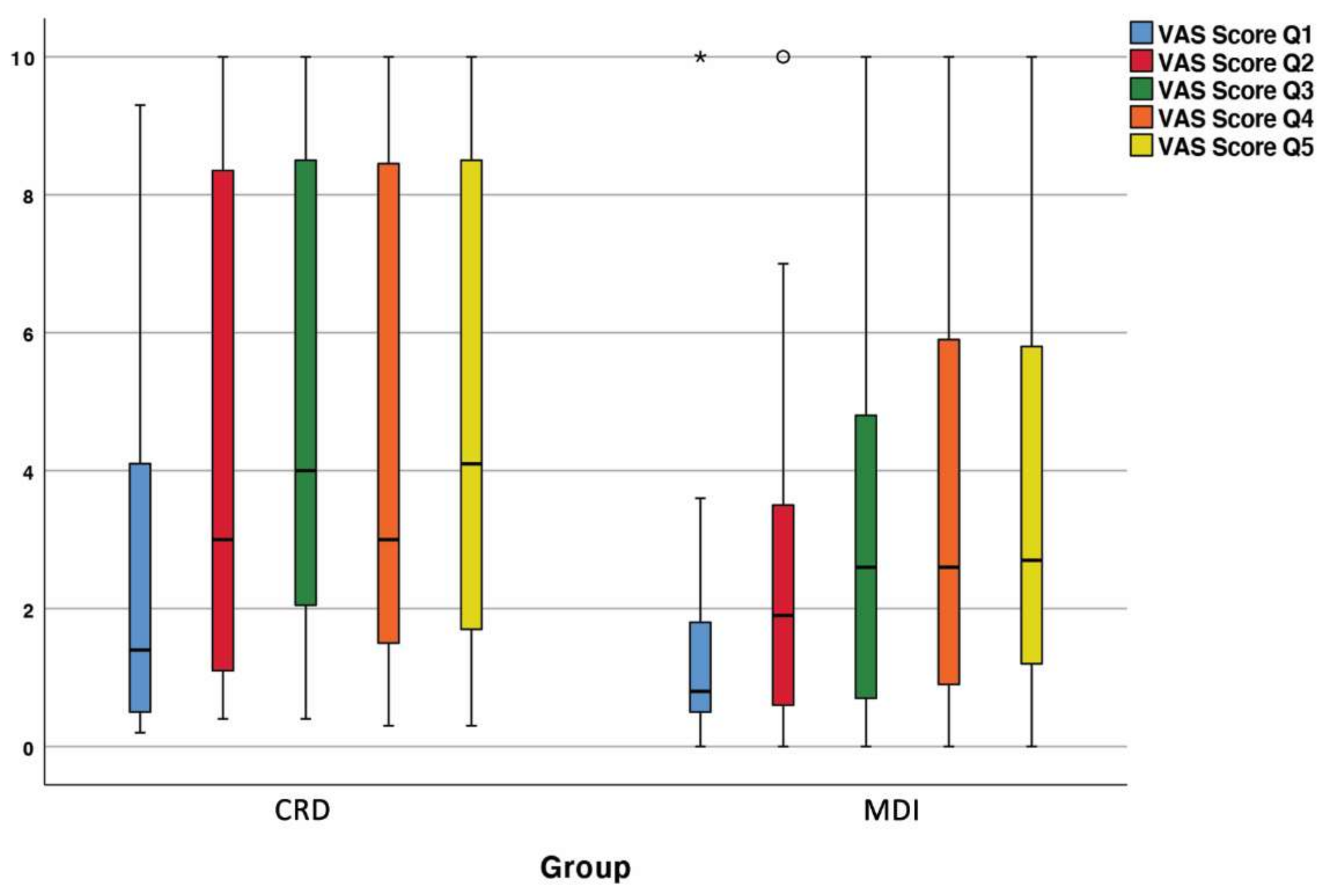Comparing Masticatory Performance of Maxillary Mini Dental Implant Overdentures, Complete Removable Dentures and Dentate Subjects
Abstract
:1. Introduction
- Comparable masticatory performance is found in MDI overdenture compared to dentate subjects;
- Comparable masticatory performance is observed in 50+ dentate subjects with 20+ dental students;
- Improved masticatory performance with MDI overdentures is found compared to subjects with CRD.
2. Materials and Methods
2.1. Study Design
- Group 1:
- 20+ dentate dental students (DS);
- Group 2:
- 50+ dentate people (DP);
- Group 3:
- 50+ maxillary CRD/dentate mandible (CRD);
- Group 4:
- 50+ maxillary MDI/dentate mandible (MDI).
2.2. MDI Overdenture Treatment
2.3. Objective Masticatory Performance Test
2.4. Subjective Masticatory Evaluation
2.5. Statistic Evaluation
3. Results
4. Discussion
5. Conclusions
- No comparable masticatory performance in maxillary MDI overdentures compared to dentate subjects;
- Comparable masticatory performance in dentate age 20+ years and age 50+ years;
- No improved masticatory performance in maxillary MDI overdentures compared to CRD in maxillary edentulous subjects.
Author Contributions
Funding
Institutional Review Board Statement
Informed Consent Statement
Acknowledgments
Conflicts of Interest
Appendix A. Visual Analogue Score for Different Food Consistencies (Soft Bread, Hard Cheese, Dry Sausage, Apple and Carrot

Appendix B. Dutch Validated Version of the OHIP-14 Questionnaire

References
- Zitzmann, N.U.; Hagmann, E.; Weiger, R. What is the prevalence of various types of prosthetic dental restorations in Europe? Clin. Oral Implant. Res. 2007, 18, 20–33. [Google Scholar] [CrossRef] [PubMed]
- Kelly, E. Changes caused by a mandibular removable partial denture opposing a maxillary complete denture. J. Prosthet. Dent. 2003, 90, 213–219. [Google Scholar] [CrossRef]
- Polzer, I.; Schimmel, M.; Müller, F.; Biffar, R. Edentulism as part of the general health problems of elderly adults. Int. Dent. J. 2010, 60, 143–155. [Google Scholar]
- Cawood, J.I.; Howell, R.A. A Classification of the edentulous jaws. Int. J. Oral Maxillofac. Surg. 1988, 17, 232–236. [Google Scholar] [CrossRef]
- Cassetta, M.; Perrotti, V.; Calasso, S.; Piattelli, A.; Sinjari, B.; Iezzi, G. Bone formation in sinus augmentation procedures using autologous bone, porcine bone, and a 50: 50 mixture: A human clinical and histological evaluation at 2 months. Clin. Oral Implant. Res. 2015, 26, 1180–1184. [Google Scholar] [CrossRef]
- Baj, A.; Lauritano, D.T.G.; Candotto, V.; Mancini, G.E.; Gianni, A.B. An overview on bone reconstruction of atrophic maxilla: Succes parameters and critical issues. J. Biol. Regul. Homeost. Agents 2016, 30, 209–215. [Google Scholar]
- Ellis, J.S.; Levine, A.; Bedos, C.; Mojon, P.; Rosberger, Z.; Feine, J.S.; Thomason, J.M. Refusal of implant supported mandibular overdentures by elderly patients. Gerodontology 2011, 28, 62–68. [Google Scholar] [CrossRef]
- Sinjari, B.; D’Addazio, G.; Traini, T.; Varvara, G.; Scarano, A.; Murmura, G.; Caputi, S. A 10-year retrospective comparative human study on screw-retained versus cemented dental implant abutments. J. Biol. Regul. Homeost. Agents 2019, 33, 787–797. [Google Scholar] [PubMed]
- Klein, M.O.; Schiegnitz, E.; Al-Nawas, B. Systematic Review on Success of Narrow-Diameter Dental Implants. Int. J. Oral Maxillofac. Implant. 2014, 29, 43–54. [Google Scholar] [CrossRef] [Green Version]
- Jung, R.E.; Al-Nawas, B.; Araujo, M.; Ortiz, G.A.; Barter, S.; Brodala, N.; Chappuis, V.; Chen, B.; De Souza, A.; Faria-Almeida, R.; et al. Group 1 ITI Consensus Report: The influence of implant length and design and medications on clinical and patient-reported outcomes. Clin. Oral Implant. Res. 2018, 29 (Suppl. 16), 69–77. [Google Scholar] [CrossRef] [PubMed] [Green Version]
- Schiegnitz, E.; Al-Nawas, B. Narrow-diameter implants: A systematic review and meta-analysis. Clin. Oral Implant. Res. 2018, 29 (Suppl. 16), 21–40. [Google Scholar] [CrossRef] [PubMed] [Green Version]
- Van Doorne, L.; De Kock, L.; De Moor, A.; Shtino, R.; Bronkhorst, E.; Meijer, G.; De Bruyn, H. Flaplessly placed 2.4-mm mini-implants for maxillary overdentures: A prospective multicentre clinical cohort study. Int. J. Oral Maxillofac. Surg. 2020, 49, 384–391. [Google Scholar] [CrossRef]
- Van Doorne, L.; Fonteyne, E.; Matthys, C.; Bronkhorst, E.; Meijer, G.; De Bruyn, H. Longitudinal Oral Health-Related Quality of Life in maxillary mini dental implant overdentures after 3 years in function. Clin. Oral Implant. Res. 2021, 32, 23–36. [Google Scholar] [CrossRef]
- Elgestad Stjernfeldt, P.; Sjögren, P.; Wårdh, I.; Boström, A.M. Systematic review of measurement properties of methods for objectively assessing masticatory performance. Clin. Exp. Dent. Res. 2019, 5, 76–104. [Google Scholar] [CrossRef]
- Ahmad, S.F. An insight into the masticatory performance of complete denture wearer. Ann. Dent. 2006, 13, 24–33. [Google Scholar] [CrossRef] [Green Version]
- Gu, Y.; Bai, Y.; Xie, X. Bite Force Transducers and Measurement Devices. Front. Bioeng. Biotechnol. 2021, 9, 665081. [Google Scholar] [CrossRef] [PubMed]
- Lucas, P.W.; Luke, D.A.; Voon, F.C.T.; Chew, C.L.; Ow, R. Food breakdown patterns produced by human subjects possessing artificial and natural teeth. J. Oral Rehabil. 1986, 13, 205–214. [Google Scholar] [CrossRef] [PubMed]
- Bates, J.F.; Stafford, G.D.; Harrison, A. Masticatory function-a review of the literature. III. Masticatory performance and efficiency. J. Oral Rehabil. 1976, 3, 57–67. [Google Scholar] [CrossRef] [PubMed]
- Van der Bilt, A.; Mojet, J.; Tekamp, F.A.; Abbink, J.H. Comparing masticatory performance and mixing ability. J. Oral Rehabil. 2010, 37, 79–84. [Google Scholar] [CrossRef]
- Manly, R.S.; Braley, L.C. Masticatory performance and efficiency. J. Dent. Res. 1950, 29, 448–462. [Google Scholar] [CrossRef] [PubMed]
- Van der Bilt, A.; Van der Glas, H.W.; Mowlana, F.; Heath, M.R. A comparison between sieving and optical scanning for the determination of particle size distributions obtained by mastication in man. Arch. Oral Biol. 1993, 38, 159–163. [Google Scholar] [CrossRef]
- Speksnijder, C.M.; Abbink, J.H.; van der Glas, H.W.; Janssen, N.G.; van der Bilt, A. Mixing ability test compared with a comminution test in persons with normal and compromised masticatory performance. Eur. J. Oral Sci. 2009, 117, 580–586. [Google Scholar] [CrossRef] [PubMed]
- Nokubi, T.; Nokubi, F.; Yoshimuta, Y.; Ikebe, K.; Ono, T.; Maeda, Y. Measuring masticatory performance using a new device and β-carotene in test gummy jelly. J. Oral Rehabil. 2010, 37, 820–826. [Google Scholar] [CrossRef]
- Montero, J.; Leiva, L.A.; Martín-Quintero, I.; Rosel, E.; Barrios-Rodriguez, R. Determinants of masticatory performance assessed by mixing ability tests. J. Prosthet. Dent. 2021. [Google Scholar] [CrossRef] [PubMed]
- Schimmel, M.; Christou, P.; Miyazaki, H.; Halazonetis, D.; Herrmann, F.R.; Müller, F. A novel colourimetric technique to assess chewing function using two-coloured specimens: Validation and application. J. Dent. 2015, 43, 955–964. [Google Scholar] [CrossRef]
- Van Doorne, L.; Gholami, P.; D’Haese, J.; Hommez, G.; Meijer, G.; De Bruyn, H. Three-Dimensional Radiographic Outcome of Free-Handed Flaplessly Placed Mini Dental Implants in Edentulous Maxillae after 2-Years Function. J. Clin. Med. 2020, 9, 2120. [Google Scholar] [CrossRef] [PubMed]
- Fonteyne, E.; Van Doorne, L.; Becue, L.; Matthys, C.; Bronckhorst, E.; De Bruyn, H. Speech evaluation during maxillary mini-dental implant overdenture treatment: A prospective study. J. Oral Rehabil. 2019, 46, 1151–1160. [Google Scholar] [CrossRef]
- Schimmel, M.; Christou, P.; Herrmann, F.; Muller, F. A two-colour chewing gum test for masticatory efficiency: Development of different assessment methods. J. Oral Rehabil. 2007, 34, 671–678. [Google Scholar] [CrossRef]
- Halazonetis, D.J.; Schimmel, M.; Antonarakis, G.; Christou, P. Novel software for quantitative evaluation and graphical representation of masticatory efficiency. J. Oral Rehabil. 2013, 40, 329–335. [Google Scholar] [CrossRef]
- Silva, L.C.; Nogueira, T.E.; Rios, L.F.; Schimmel, M.; Leles, C.R. Reliability of a two-colour chewing gum test to assess masticatory performance in complete denture wearers. J. Oral Rehabil. 2018, 45, 301–307. [Google Scholar] [CrossRef] [PubMed]
- Feine, J.S.; Lund, J.P. Measuring chewing ability in randomized controlled trials with edentulous populations wearing implant prostheses. J. Oral Rehabil. 2006, 33, 301–308. [Google Scholar] [CrossRef] [PubMed]
- Slade, G.D. Assessing change in quality of life using the Oral Health Impact Profile. Community Dent. Oral Epidemiol. 1998, 26, 52–61. [Google Scholar] [CrossRef] [PubMed]
- McGrath, C.; Bedi, R. Measuring the impact of oral health on life quality in two national surveys-functionalist versus hermeneutic approaches. Community Dent. Oral Epidemiol. 2002, 30, 254–259. [Google Scholar] [CrossRef]
- Pommer, B. Use of the Oral Health Impact Profile (OHIP) in clinical oral implant research. J. Dent. Oral Craniofac. Epidemiol. 2013, 1, 3–10. [Google Scholar]
- Raes, S.; Raes, F.; Cooper, L.; Giner-Tarrida, L.; Vervaeke, S.; Cosyn, J.; De Bruyn, H. Oral health-related quality of life changes after placement of immediately loaded single implants in healed alveolar ridges or extraction sockets: A 5-year prospective follow-up study. Clin. Oral Implant. Res. 2017, 28, 662–667. [Google Scholar] [CrossRef]
- Slade, G.D. Derivation and validation of a short-form oral health impact profile. Community Dent. Oral Epidemiol. 1997, 25, 284–290. [Google Scholar] [CrossRef]
- Locker, D. Measuring oral health: A conceptual framework. Community Dent. Health 1988, 5, 3–18. [Google Scholar]
- Van Der Meulen, M.J.; John, M.T.; Naeije, M.; Lobbezoo, F. The Dutch version of the Oral Health Impact Profile (OHIP-NL): Translation, reliability and construct validity. BMC Oral Health 2008, 8, 11. [Google Scholar] [CrossRef] [Green Version]
- Kuoppala, R.; Napankangas, R.; Raustia, A. Quality of Life of Patients Treated With Implant-Supported Mandibular Overdentures Evaluated With the Oral Health Impact Profile (OHIP-14): A Survey of 58 Patients. J. Oral Maxillofac. Res. 2013, 4, e4. [Google Scholar] [CrossRef] [Green Version]
- Yamada, A.; Kanazawa, M.; Komagamine, Y.; Minakuchi, S. Association between tongue and lip functions and masticatory performance in young dentate adults. J. Oral Rehabil. 2015, 42, 833–839. [Google Scholar] [CrossRef] [PubMed]
- Shu, X.; Fan, Y.; Lo, E.C.M.; Leung, K.C.M. A systematic review and meta-analysis to evaluate the efficacy of denture adhesives. J. Dent. 2021, 108, 103638. [Google Scholar] [CrossRef]
- Kapur, K.K. A clinical evaluation of denture adhesives. J. Prosthet. Dent. 1967, 18, 550–558. [Google Scholar] [CrossRef]
- Yamaga, E.; Sato, Y.; Minakuchi, S. A structural equation model relating oral condition, denture quality, chewing ability, satisfaction, and oral health-related quality of life in complete denture wearers. J. Dent. 2013, 41, 710–717. [Google Scholar] [CrossRef] [PubMed]
- Heydecke, G.; Klemetti, E.; Awad, M.A.; Lund, J.P.; Feine, J.S. Relationship between prosthodontic evaluation and patient ratings of mandibular conventional and implant prostheses. Int. J. Prosthodont. 2003, 16, 307–312. [Google Scholar] [CrossRef]
- Ikebe, K.; Amemiya, M.; Morii, K.; Matsuda, K.-I.; Furuya-Yoshinaka, M.; Yoshinaka, M.; Nokubi, T. Association between oral stereognostic ability and masticatory performance in aged complete denture wearers. Int. J. Prosthodont. 2007, 20, 245–250. [Google Scholar]
- Ikebe, K.; Matsuda, K.-I.; Kagawa, R.; Enoki, K.; Okada, T.; Yoshida, M.; Maeda, Y. Masticatory performance in older subjects with varying degrees of tooth loss. J. Dent. 2012, 40, 71–76. [Google Scholar] [CrossRef] [PubMed]
- Meyer, G.; Fanghänel, J.; Proff, P. Morphofunctional aspects of dental implants. Ann. Anat. 2012, 194, 190–194. [Google Scholar] [CrossRef]
- Leles, C.R.; Oliveira, T.M.C.; De Araújo, S.C.; Nogueira, T.E.; Schimmel, M. Individual factors associated with masticatory performance of complete denture wearers: A cross-sectional study. J. Oral Rehabil. 2019, 46, 903–911. [Google Scholar] [CrossRef] [PubMed]
- Tarkowska, A.; Katzer, L.; Ahlers, M.O. Assessment of masticatory performance by means of a color-changeable chewing gum. J. Prosthodont. Res. 2017, 61, 9–19. [Google Scholar] [CrossRef] [PubMed]
- Sato, S.; Fueki, K.; Sato, H.; Sueda, S.; Shiozaki, T.; Kato, M.; Ohyama, T. Validity and reliability of a newly developed method for evaluating masticatory function using discriminant analysis. J. Oral Rehabil. 2003, 30, 146–151. [Google Scholar] [CrossRef]
- Morita, K.; Tsuka, H.; Kato, K.; Mori, T.; Nishimura, R.; Yoshida, M.; Tsuga, K. Factors related to masticatory performance in healthy elderly individuals. J. Prosthet. Dent. 2018, 120, 35–42. [Google Scholar] [CrossRef] [PubMed]
- Carlsson, G.E.; Omar, R. The future of complete dentures in oral rehabilitation. A critical review. J. Oral Rehabil. 2010, 37, 143–156. [Google Scholar] [CrossRef] [PubMed]





| Group (N) | Mean Age (SD) | Gender (Male/Female) |
|---|---|---|
| DS (22) | 24.18 (2.37) | 10/12 |
| DP (19) | 60.53 (8.29) | 11/8 |
| CRD (20) | 68.4 (6.86) | 12/8 |
| MDI (20) | 65.75 (8.21) | 9/11 |
Publisher’s Note: MDPI stays neutral with regard to jurisdictional claims in published maps and institutional affiliations. |
© 2021 by the authors. Licensee MDPI, Basel, Switzerland. This article is an open access article distributed under the terms and conditions of the Creative Commons Attribution (CC BY) license (https://creativecommons.org/licenses/by/4.0/).
Share and Cite
Van Doorne, L.; De Backer, B.; Matthys, C.; De Bruyn, H.; Vandeweghe, S. Comparing Masticatory Performance of Maxillary Mini Dental Implant Overdentures, Complete Removable Dentures and Dentate Subjects. J. Clin. Med. 2021, 10, 5006. https://doi.org/10.3390/jcm10215006
Van Doorne L, De Backer B, Matthys C, De Bruyn H, Vandeweghe S. Comparing Masticatory Performance of Maxillary Mini Dental Implant Overdentures, Complete Removable Dentures and Dentate Subjects. Journal of Clinical Medicine. 2021; 10(21):5006. https://doi.org/10.3390/jcm10215006
Chicago/Turabian StyleVan Doorne, Luc, Ben De Backer, Carine Matthys, Hugo De Bruyn, and Stefan Vandeweghe. 2021. "Comparing Masticatory Performance of Maxillary Mini Dental Implant Overdentures, Complete Removable Dentures and Dentate Subjects" Journal of Clinical Medicine 10, no. 21: 5006. https://doi.org/10.3390/jcm10215006







